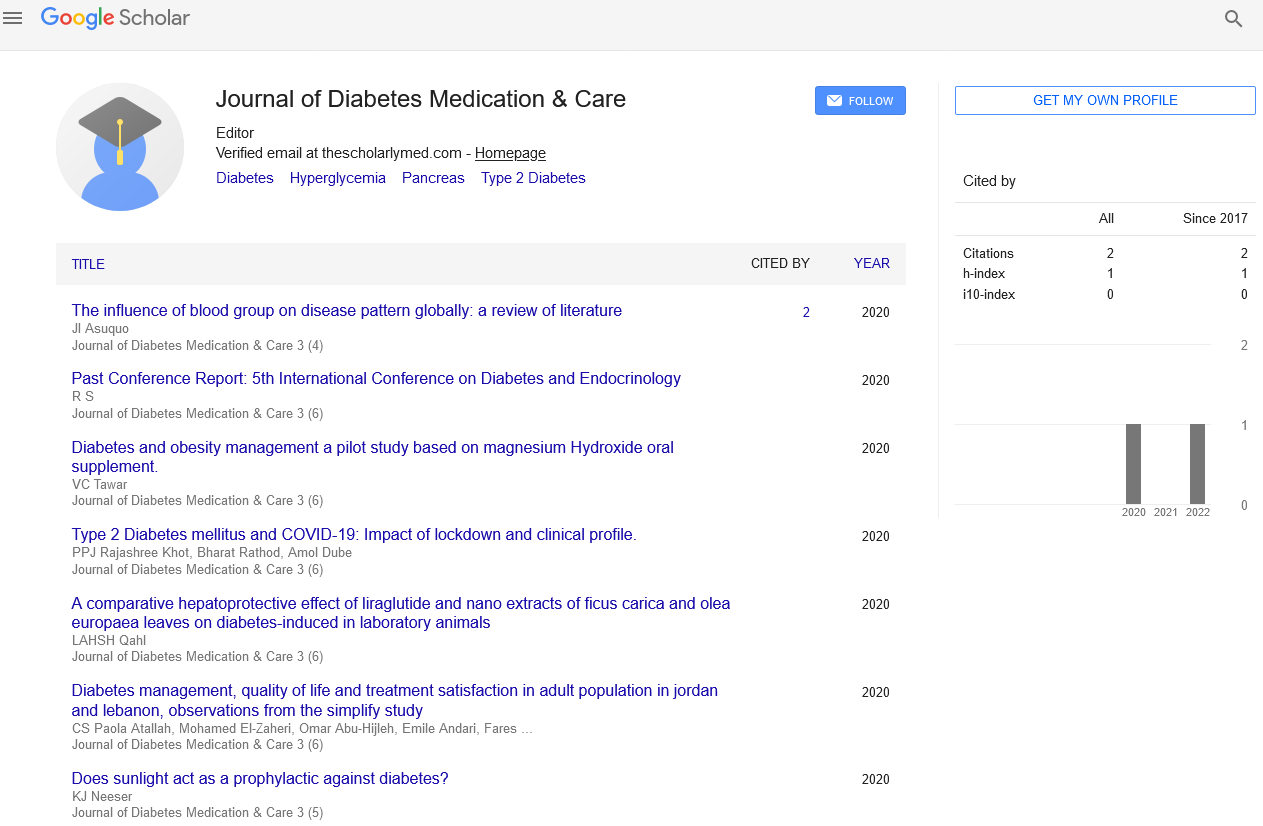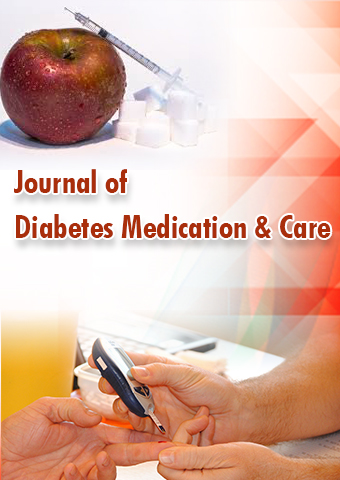Review Article - Journal of Diabetes Medication & Care (2022) Volume 5, Issue 4
The female Breast and Diabetes
Ricky Jhonson*
Democritus University of Thrace, Komotini, Greece
Received: 02-Aug-2022, Manuscript No. JDMC-22- 72454; Editor assigned: 06-Aug-2022, PreQC No. JDMC-22-72454 (PQ); Reviewed: 20- Aug-2022, QC No. JDMC-22-72454; Revised: 23-Aug-2022, Manuscript No. JDMC-22-72454 (R) ; Published: 30-Aug-2022 DOI: 10.37532/ jdmc.2022.5(4).60-62
Abstract
The present review outlines the various issues of breast pathology in diabetes. Diabetic mastopathy is an uncommon proliferation of fibrous tissue in the breast that mimics tumour. Breast arterial calcifications represent calcium deposits in the media of arterioles and are more frequently detected on mammograms of diabetic subjects. Importantly, type 2 diabetes mellitus (T2DM) has been associated with breast cancer, but the mechanism underlying this association is complex, since the two entities frequently co-exist and seem to share common aetiological factors and pathways. Furthermore, diabetes has been suggested to negatively affect breast cancer outcomes, but it is unclear whether better glycaemic control would ameliorate prognosis. Preliminary data suggest that antidiabetic treatment may also influence both the incidence and prognosis of breast cancer. However, available evidence is inconclusive and further research is needed. Therefore, treatment of diabetes should not be determined by its potential effect on breast cancer.
Keywords
Diabetes mellitus • Breast cancer • Diabetic mastopathy • Hypoglycemic agents
Introduction
Diabetes mellitus is a public health burden affecting almost 7% of the adult population [1]. Beyond the traditional macro and micro vascular complications, diabetes seems to also affect multiple organs in different ways, for instance the hand.
The breast is also affected in diabetes in many ways. Diabetic mastopathy, was first described in 1984, and has received much attention, but it is still not decisively established as a complication of diabetes. Conversely, breast arterial calcifications have more firmly been related to diabetes and its complications. Vice versa, they have been considered to be a marker of generalised cardiovascular disease and have even been proposed to be indicative of undiagnosed diabetes if detected on mammography, although it is important to remember that they are not only related to diabetes [2-3].
Description
Diabetic mastopathy was first described in 1984, but it is still poorly diagnosed and not conclusively established as a complication of diabetes. Breasts, as expected, are neglected in the routine clinical examination of diabetic patients and, therefore, the prevalence of this complication is unknown, although it has been estimated to represent a very small proportion of benign breast lesions. Diabetic mastopathy is an uncommon proliferation of fibrous tissue in the breast that mimics tumour. It was first reported to affect one breast in premenopausal women with long-standing type 1 diabetes mellitus. Later, however, it was additionally described in older women with type 2 diabetes and it may affect both breasts. Diagnosing diabetic mastopathy is a challenge for both clinicians and radiologists.
When breast examination reveals any changes, common imaging techniques include mammography and ultrasonography. Diabetic mastopathy in mammography is shown as asymmetric densities and parenchymal deformity, whereas ultrasonography shows irregular hypo-echoic mass and moderate to marked acoustic shadowing. Contrast enhanced magnetic resonance imaging (MRI) and MR spectroscopy has also been suggested to additionally contribute to the differential diagnosis. Nevertheless, no imaging modality is entirely reliable in differentiating diabetic mastopathy from malignancy, and so core biopsy is essential for accurate diagnosis when mammography and/or ultrasonography are indicative of potential malignancy. Since fineneedle aspiration cytology (FNAC) guided by ultrasound is usually difficult to perform due to resistant fibrous tissue, core biopsy guided by ultrasound is preferable [4]. Typical histological features of diabetic mastopathy include dense, keloid-type fibrosis, lymphocytic ductitis/lobulitis, atrophic mammary lobules, perilobular and perivascular lymphocytic infiltration. Conclusively, BACs have been suggested to be a marker of generalised cardiovascular disease and are not related only to diabetes. Therefore, the question whether these mammographic findings could be used for the identification of women at high risk for diabetes or coronary artery disease remains to be answered. Further research is needed but, until then, reporting such findings is not recommended in everyday clinical practice. Diabetes mellitus and breast cancer are quite prevalent chronic diseases among women and sometimes co-exist. Both are public health burdens, and they seem to share common risk factors and common pathways. Interestingly, diabetes mellitus and antidiabetic treatment have also been suggested to influence the incidence, therapy and prognosis of breast cancer, suggesting that implementation of common preventive and therapeutic strategies might be useful to control both diseases. Insulin is a growth factor, and chronic hyperinsulinaemia has been proposed to induce cancer on insulinsensitive tissues, such as the breast. Insulin has been demonstrated to have mitogenic effects on breast tissue. Of note, insulin receptors are frequently over-expressed in breast cancer cells. Insulin exerts its action through binding to its receptor. The insulin–insulin receptor complex activates the phosphatidylinositol 3-kinase (PI3-K), which, in turn, activates the pathway regulated by PI3K-regulated protein kinase. The latter pathway plays a significant role in mitogenic signaling.
Impaired regulation of endogenous sex hormones
Insulin resistance and increased circulating insulin reduce levels of sex hormone-binding globulin (SHBG), thereby increasing the bioavailability of endogenous oestrogens and androgens, which are associated with a higher risk for postmenopausal breast cancer. Increased leptin levels induce proliferation of breast cancer cells through the activation of mitogen-activated protein kinase (MAPK) and PI3-K signaling pathways. At the same time, decreased adiponectin has been associated with increased risk for breast cancer, as adiponectin seems to inhibit tumour cell proliferation. Finally, other inflammatory cytokines, like PAI-1, have been linked to poor breast cancer outcomes. Safety concerns about the possible carcinogenic effect of insulin use in diabetic patients arose when reported a dose-dependent increase in the risk of developing cancer among patients treated with insulin glargine, compared with the use of human insulin, but not with the use of lispro or aspart. This effect of glargine was probably ascribable to its increased binding to the IGF1 receptor. Conflicting data regarding the mitogenic role of insulin were also reported in a study conducted in Sweden. Diabetic women treated only with insulin glargine had an RR for breast cancer of 1.99 (95% CI: 1.31–3.03), as compared with the use of other types of insulin. Nonetheless, the risk did not increase when glargine was combined with other insulin [5]. The authors concluded that a causal relationship between cancer and glargine use cannot be established.
First, diabetic mastopathy is an uncommon proliferation of fibrous tissue in the breast that mimics tumour. In practice, this entity may be ignored unless problems of differential diagnosis from breast malignancies arise. Secondly, diabetic women may exhibit breast arterial calcifications, which represent calcium deposits in the media of arterioles that may be detected on routine mammograms. Of note, the question whether these findings could be used for the identification of women at high risk for diabetes has not yet been answered, since they are not only related to diabetes but also to other factors, such as age, hypertension, and hypercholesterolaemia. Thus, reporting such findings in everyday practice is not recommended. More importantly, T2DM has been associated with breast cancer, but the relationship between the two entities is very complex and is, certainly, far from being causal. Additionally, it has been suggested that diabetes might negatively affect breast cancer prognosis. Nevertheless, it is currently premature to infer that optimised glycaemic control would confer a beneficial effect on breast cancer outcomes.
Acknowledgement
None
Conflict of Interest
No conflict of interest
References
- Alicic RZ, Rooney MT. Diabetic kidney disease: challenges, progress, and possibilities. Clin J Am Soc Nephrol.12, 342-356 (2017).
- Ritz E, Zeng XX, Rych I et al. Clinical manifestation and natural history of diabetic nephropathy. Cont rib Nephrol. 170, 132-155 (2011).
- Doshi SM, Friedman AN. Diagnosis and management of type 2diabetic kidney disease. Clin J A Soc Nephrol.12, 136-156 (2017).
- Pugliese G. Updating the natural history of diabetic nephropathy. Act Diabetol. 51, 905-943(2015).
- American Diabetes Association. Standards of medical care in diabetes. Diabetes Care. 41,152-167 (2005).
Indexed at, Google Scholar, Crossref
Indexed at, Google Scholar, Crossref
Indexed at, Google Scholar, Crossref

